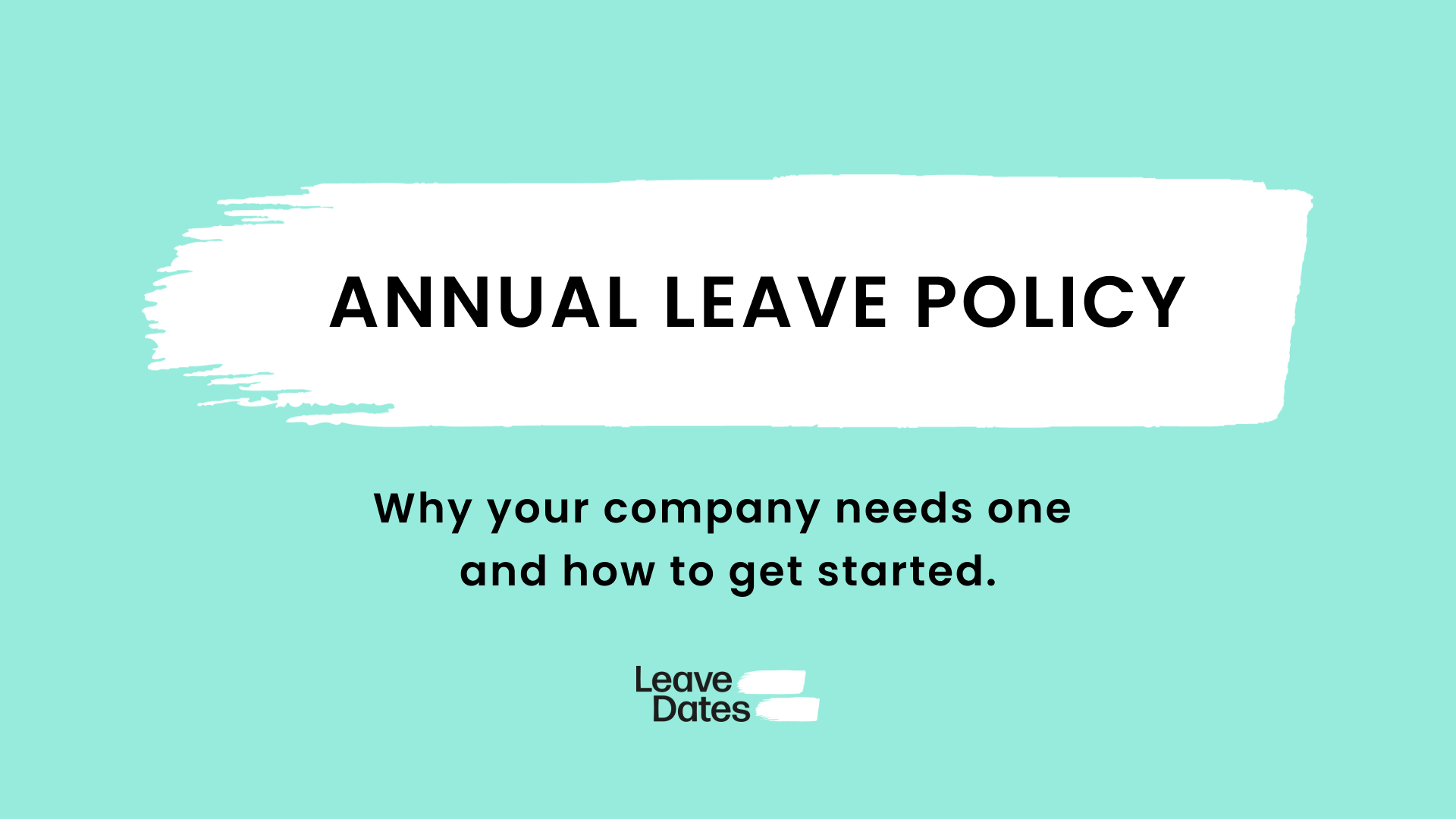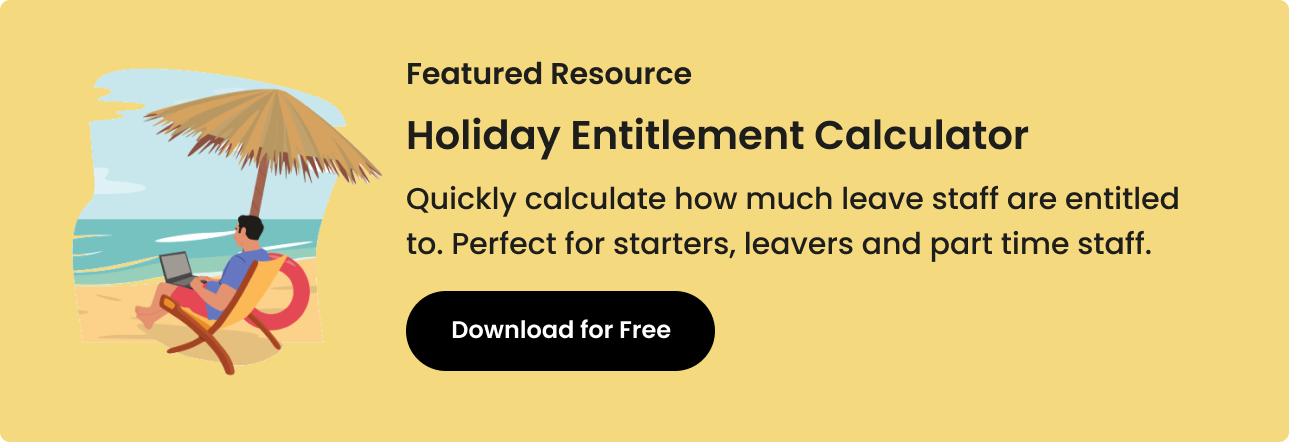
Annual leave is the time off that an employee accrues and is entitled to on a yearly basis. It’s hugely important to both employees and employers, for all manner of reasons (read about them here). Legally, all employees have the right to a certain amount of time off based on the hours they work, but many companies go beyond this and document a set of guidelines that cover the rights and eligibility of employees with regard to different types of paid and unpaid leave. Having a clear and well-communicated policy is invaluable, as it avoids ambiguities and disagreements about requests for leave that can quickly escalate to become broader HR issues, or create a negative workplace environment. Every company needs a leave policy, and there’s no reason they should be challenging or time-consuming to put together. Once it’s in place, you can sit back and forget about it until it’s time to book a holiday! This article will help get you started by highlighting the key information that should be included in your company’s annual leave policy.
Purpose
It’s important to clearly communicate to employees why there is an annual leave policy in place, and to whom it relates.
Example:[Company Name] recognised the importance of supporting its employees in achieving a healthy work-life balance, and has provided this policy giving information on the availability, eligibility and process for requesting different types of paid and unpaid leave.
This policy applies to all employees of [Company Name].
If staff feel the policy is there for their benefit, they will be more likely to respect and refer to it. It also encourages employees to take their full holiday allowance — if they’re not aware of their entitlement, and they don’t feel a request for time off would be well-received, they may avoid asking. This benefits no one.
Leave year
Here you should explain over what period leave allowances are calculated, whether that’s from 1st January, the first day of your company’s financial year, or any other date. Your employees may not know automatically when this date is, so this should be clearly indicated to avoid confusion or disappointment.
Entitlement and restrictions
Employees may be entitled to different amounts of annual leave depending on their employment status, contract type, and length of service. The annual leave policy should clearly specify what these allowances are and how they are calculated. It should be made clear whether allowances are inclusive of public holidays or not.
You might also want to consider including points of clarification for leavers (e.g. what their status is should they leave having taken more holiday than they have accrued, or if they are owed leave not yet taken), or new staff starting in the middle of the year (e.g. that their entitlement will be calculated pro rata based on the proportion of the year worked).
If there are any times of year when leave is restricted (e.g. a ‘peak’ period), this must be documented here for staff to refer to.
The policy should also clarify whether employees are able to carry-over unused leave to the next year and whether there are any restrictions or conditions that apply to this.
Example:Full-time employees are entitled to 25 days of annual leave per year. After every 2 years of employment, an additional 1 day of annual leave will be added to the employee’s overall entitlement, up to a maximum of 28 days after 6 years. The annual leave entitlement is in addition to UK public holidays. Part-time employees will receive the above entitlement prorated based on their working hours rounded up to the nearest half day.
Employees in their first year of employment will receive the standard leave entitlement prorated based on the proportion of the year they will work, rounded up to the nearest half day.
Employees who leave the organisation will have their entitlement prorated based on the proportion of the year they worked, rounded up to the nearest half day. Any excess leave taken will be deducted from their final pay, any untaken entitlement will be added to their final pay.
Employees who have not taken their full entitlement of leave during a leave year are allowed to carry over a maximum of 5 days into the following year if approved by their line manager.

Types of leave
As well as annual leave, it’s likely that there are other types of leave permitted by the company, such as maternity/paternity, study leave, unpaid leave, jury service, etc. The policy should list all types of leave allowed by the company, what conditions or restrictions apply to each (eligibility, allowances), whether they are paid or unpaid, and whether the process of requesting a particular type of leave differs from the standard.
Example:Study Leave
Employees studying for an approved course will be entitled to 2 days of paid study leave per module up to a maximum of six days per year.
Jury Service Leave
If an employee is called for jury service, they must inform their manager and provide a copy of the court summons as soon as possible. The employee is entitled to take time off for the duration of the case but must return to work immediately on completion.
Unpaid Leave
Employees are allowed to take time off as unpaid leave at the discretion of their line manager.
Request process
The policy should set out a clear process for requesting and approving leave so that all staff know what they must do if they want particular time off, and how and when they will know if it’s been granted.
Example:Requests for leave should be made electronically using the leavedates.com platform as far in advance as possible to allow managers to arrange cover where necessary. Employees should avoid making any arrangements until their leave request has been approved via the same system. [Company Name] will not be liable for any loss incurred by employees having to cancel arrangements due to declined leave requests.
What guidelines work for your company?
The above are just some of the areas your leave policy should cover, but their content will vary across companies and industries. At a bare minimum, your annual leave policy must conform with relevant government legislation in the country (or countries) you operate within. For UK companies, your policy must meet the requirements set out on gov.uk (www.gov.uk/browse/employing-people/time-off). For US companies, guidelines are provided by the Office of Personnel Management (www.opm.gov/policy-data-oversight/pay-leave/leave-administration/fact-sheets/annual-leave/).
However, you should think about whether the bare minimum is enough for you and your employees. Do you do the bare minimum in other areas of your business? There is growing support and research behind the idea of generous, even ‘unlimited’ time off policies. As I discussed in a previous article, in the modern world, work-life balance is much prized; as if you want to attract (and retain) top talent, a good amount of leave is one of the most sought-after job perks. Whether that’s through a standard leave policy that trumps that of your competitors, or a graduated scheme that rewards length of service with an increased paid leave allowance, people in all industries and roles will appreciate more time to step back and recharge. Contrary to what you may think, it isn’t attached with a hefty cost, either, as overall time off has been shown to increase employee engagement and productivity, help avoid burnout and reduce the dreaded staff turnover. These are all things to think about when putting together your company’s annual leave policy. If you put the time in now, your staff will thank you later.
****
Of course, in addition to an annual leave policy, you’ll also need a system for implementing it and handling the practical side of things, to make sure your policy can be put into action without a hitch. If you don’t already use a dedicated app or tool to manage annual leave, days off, and working patterns, you might want to check out Leave Dates. The ability to see everyone’s availability all in one place, in a visual and clear way, makes planning projects, holiday, meetings, and events much less stressful. Leave Dates removes the effort of manually managing leave and absence, giving you more time to get on with more important things, like running a business! The app is free for small teams and works on laptops, tablets and mobile phones.



